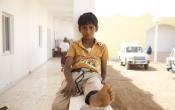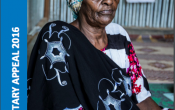Yemen
Operation: Yemen
Location
{"longitude":48,"latitude":16,"zoom_level":0}
Latest update of camps and office locations 13 Jan 2016. By clicking on the icons on the map, additional information is displayed.
Key Figures
| 2015 end-year results | |
| 3,200 | refugees and asylum-seekers with specific needs received cash assistance |
| 3,000 | Syrian refugees were granted temporary protection |
| 19,000 | IDPs were found to have specific needs during protection monitoring |
| 15,000 | IDPs received with cash assistance, as well as legal and psycho-social assistance |
| 288,000 | IDPs received core relief items in 19 governorates |
| 2016 planning figures | |
| 16% | Global acute malnutrition (GAM) (at baseline) (refugees and asylum-seekers in Yemen) |
| 20,000 | Number of emergency shelters provided (at baseline) (IDPs in Yemen) |
| 1,300 | Number of refugees and asylum-seekers targeted to receive cash grants |
| 90 | Number of community self-management structures to be strengthened |
Latest Updates and Related Links
People of Concern
309%
Increase in
2015
2015
| 2015 | 2,809,088 |
| 2014 | 686,217 |
| 2013 | 649,158 |

[["Refugees",267173],["Asylum-seekers",9866],["IDPs",2532032],["Others of concern",17]]
Loading ...
Budgets and Expenditure for Yemen
< Back
2015
{"categories":[2012,2013,2014,2015,2016],"budget":[72.668548722,73.02036891,55.90237687,107.42361363,124.06305842],"expenditure":[44.49582488,45.55776942,32.43507863,59.1504741,null]}
{"categories":[2012,2013,2014,2015,2016],"p1":[34.512571472,34.65978173,37.76781567,54.5338847,48.97075377],"p2":[null,null,null,null,null],"p3":[null,null,null,null,null],"p4":[38.15597725,38.36058718,18.1345612,52.88972893,75.09230465]}
{"categories":[2012,2013,2014,2015,2016],"p1":[26.0299673,24.32612142,24.52485244,30.6292506,null],"p2":[null,null,null,null,null],"p3":[null,null,null,null,null],"p4":[18.46585758,21.231648,7.91022619,28.5212235,null]}
Loading ...
CHOOSE A YEAR
- 2014
- 2015
- 2016
Working environment
- From March 2015, escalating conflict further deteriorated the precarious humanitarian situation and socio-economic environment.
- Levels of displacement, along with the number of persons of concern with specific needs, increased throughout the year, and thousands of civilians were killed. Access to services and livelihoods were significantly reduced.
- A system-wide Level-3 emergency was declared in July 2015.
- Limited humanitarian access hindered protection and assistance activities.
- Following the temporary relocation of international staff, UNHCR continued operations with the national staff in Yemen. By mid-May 2015, international staff returned but only to Sana’a.
Population trends
- By the end of 2015, some 267,000 refugees, 95 per cent of which were Somalis, and 10,000 asylum-seekers, 83 per cent of which were Ethiopians, were in Yemen.
- Some 13 per cent of 92,000 new arrivals – 89 per cent of which were Ethiopians – were deemed in need of international protection.
- By year end, the number of internally displaced persons (IDPs) in Yemen increased to approximately 2.5 million people.
Achievements and impact
- Regular interaction was maintained with the authorities to safeguard protection space and access services.
- Protection monitoring, reception and services to refugees, asylum-seekers and new arrivals, as well as services in Kharaz camp for 18,000 Somali refugees, were maintained year-round. Financial assistance was expanded to categories of vulnerable refugees and, exceptionally, asylum-seekers. Assistance amounts were increased.
- On 10 April 2015, UNHCR issued a Position on Returns to Yemen calling on all countries to allow civilians fleeing Yemen to access their territories and urging governments to suspend forcible returns to Yemen.
- The Office contributed to the Proposal for Strategic Action in the Gulf of Aden and the Red Sea, with a special focus on the Yemen situation (‘Gulf of Aden Strategy’) developed by UNHCR and IOM.
- A Task Force on Population Movement providing statistical reporting on IDPs was established in April and was co-led with the International Organization for Migration. UNHCR covered 10 governorates.
- A call centre was launched to ensure two-way communication between persons of concern and UNHCR on services and specific needs, community engagement, and accountability.
Unmet needs
- There continued to be a backlog due to the suspension of registration and refugee status determination activities for several months. Despite advocacy, government HIV/hepatitis testing remained mandatory for the issuance/renewal of Somali refugee certificates. Further, temporary protection certificates for Syrians are not recognized as legal documents and can only be used to access services.
- As a result of restricted access to populations affected and limited capacity and resources, UNHCR could only reach and assist a certain number of persons of concern.
- UNHCR was not able to implement a voluntary repatriation pilot project for 1,000 Somali refugees. Moreover, it could not implement UNHCR’s policy on alternatives to camps.
Working environment
Since 2011, Yemen’s transitional Government has been challenged by political instability and insecurity that have further weakened the country’s social and economic situation. Internal conflicts – including tribal clashes, attacks and separatist movements – continue to create new displacement.Yemen is a transit country of mixed migration flows, including asylum-seekers and migrants. The country hosts approximately 246,000 registered refugees, 95 per cent of whom are Somalis. The majority of asylum-seekers are from Ethiopia, representing more than three quarters of new arrivals in the ‑first half of 2014.
Most Syrians in Yemen remain unregistered, with only some 2,000 having approached UNHCR by mid-2014. As of August 2014, Yemen was granting temporary protection to Syrians, allowing them to access services available to other refugees. More are expected to register.
While the number of people internally displaced in Yemen fell by 20 per cent in 2013, mainly due to mass returns to Abyan Governorate in southern Yemen, the numbers increased significantly again in 2014 as a result of ongoing conflicts in the north. As of July 2014, more than 334,000 people were registered as internally displaced.
Despite the challenges, Yemen’s hospitality towards refugees is remarkable and the country is a signatory to the 1951 Refugee Convention and its 1967 Protocol. Among other contributions, Yemen continues to provide land and security for Kharaz refugee camp, as well as access for refugees to the public health system and education in urban areas.
Needs and strategies
UNHCR’s core strategy in 2015 aims to protect refugees and asylum-seekers, in particular by strengthening refugee status determination (RSD) activities and legal counselling. Detention monitoring and advocacy will be prioritized. The Office will also capitalize on the positive protection space, undertaking joint registration and training activities, as well as promotion of refugee law with the Government.The Office will continue to seek durable solutions for refugees. Solutions will include resettlement for individuals who face no alternative, and the voluntary repatriation of Somali refugees, on an individual basis and within the regional framework. Social and economic integration will be pursued through the mainstreaming of health and education activities, as well as the promotion of self-reliance and livelihood opportunities.
Technical support will be extended to the Government for its regional coordination and the follow-up and implementation of the Sana’a Declaration, which was adopted in November 2013. The declaration aims to address challenges related to regional mixed migration and refugee flows.
In promoting durable solutions for IDPs, UNHCR, in the context of the UN Country Team, will support Yemen in assuming its responsibility for implementing the national IDP policy. Advocacy and training remain important needs and will be supported by strengthening the community-based protection-monitoring networks. This will enable the internally displaced to better understand their rights and how to obtain available support.






